A slicer is essential for 3D printing, converting digital 3D models into machine-readable instructions. Bambu Studio is the slicer designed for Bambu Lab printers, offering an intuitive interface and optimized settings. It takes STL files, slices them into printable layers, and generates the necessary G-code for the printer to follow.
Before slicing, ensure your printer profile and plate type...
A slicer is essential for 3D printing, converting digital 3D models into machine-readable instructions. Bambu Studio is the slicer designed for Bambu Lab printers, offering an intuitive interface and optimized settings. It takes STL files, slices them into printable layers, and generates the necessary G-code for the printer to follow.
Before slicing, ensure your printer profile and plate type are correctly selected. For the Bambu Labs P1P, the textured PEI plate is a reliable choice. The layer height determines print quality and speed, with 0.2mm being ideal for terrain. Lower layer heights improve detail but significantly increase print time, while higher settings can speed up printing at the cost of visible layer lines.
One of the most important settings is infill density, which determines the internal structure of prints. 10% grid infill provides a good balance between material efficiency and durability. Avoid unnecessary solid printing, as it wastes filament without adding much strength. For terrain, grid infill is more than sufficient to maintain structural integrity.
Arranging models efficiently on the build plate can save time and filament. Auto-arrange tools in Bambu Studio help maximize space, ensuring optimal placement. When dealing with multiple prints, locking objects in place prevents accidental repositioning. Before printing, use the preview mode to check layer-by-layer print paths and identify potential issues.
Once the slicing is complete, the file is ready to be sent to the printer. Bambu Studio connects directly to Bambu Lab printers, allowing for wireless printing and real-time monitoring. Additional options like bed leveling and flow calibration help ensure consistent results. With the right slicer settings, you can efficiently produce high-quality terrain without unnecessary material waste.

 Part 3 - How to Set Up your Bambu Labs P1P 3D Printer
Part 3 - How to Set Up your Bambu Labs P1P 3D Printer
 Part 1 - How FDM Printers Work
Part 1 - How FDM Printers Work
 Part 2 - Everything you need to buy to start 3D printing terrain
Part 2 - Everything you need to buy to start 3D printing terrain
 Part 5 - How to use Brims and Supports
Part 5 - How to use Brims and Supports
 Part 6 - How to Find Good STLs
Part 6 - How to Find Good STLs
 Part 7 - Common Issues
Part 7 - Common Issues








